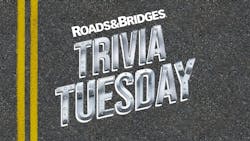Trivia Tuesday, July 29
Last week's answer
Question: What U.S. city has the most roundabouts?
Answer: A. Carmel, Indiana
Nestled just north of Indianapolis, Carmel, Ind., holds the crown as the U.S. city with the most roundabouts.
The city boasts 142 modern roundabouts — a number that has steadily climbed since construction of its first in 1996 and into the 140s by 2022 under the leadership of former Mayor James Brainard, according to the Institute of Transportation Engineers. Other estimates place the total between 138 and 145, but all agree: no other U.S. city compares.
Carmel’s transformation began in the late 1990s, when city planners, led by Brainard, embarked on an ambitious campaign to reduce traffic accidents, emissions and congestion.
Roundabouts were central to this strategy. According to Brainard’s administration, replacement of traditional intersections led to dramatic improvements — reducing intersection collisions by nearly half and slashing carbon emissions and fatalities.
An article on Panethos lists other U.S. cities that followed suit — Colorado Springs (61), Loveland, Colo. (47), Frisco, Texas (45), Charlotte (44), Lincoln, Neb. (43), and others — but none approach Carmel’s count.
Modern roundabouts differ from older traffic circles or rotaries in key ways. Introduced in the U.S. after 1960, they use yield-at-entry rules and design elements that slow traffic and reduce conflict points. Compared with signal-controlled intersections, these roundabouts significantly reduce vehicle collisions, injuries and serious or fatal crashes.
While older traffic circles date back to the early 20th century — such as Columbus Circle in New York and the Los Alamitos Traffic Circle in Long Beach, Calif. — widespread adoption of modern roundabouts began around 1990. By 2011, there were about 3,000 in the U.S., and by 2022, that number had grown to near 8,800.
States like Wisconsin and cities such as Urbana, Ohio, and Rio Rancho, N.M., have launched public awareness campaigns to help motorists adjust to the intersection design. Innovations continue to emerge: California recently introduced its first "turbo" roundabout, designed for spiral-lane flow.
In Philadelphia, state officials announced plans in April to double the number of roundabouts by 2029, adding three in the city and 29 across surrounding suburbs — raising the total to 54 in those counties, according to an article from Axios.
Projects like the conversion of the Wyoming and Castor avenues traffic circle in North Philly — set to wrap by March next year — reflect a national trend of replacing signalized intersections with safer, more efficient designs.
Carmel’s roundabout push has become emblematic of the movement. A 2023 Time article citing the city’s 140-plus roundabouts highlighted dramatic declines in traffic-death rates, congestion and carbon emissions. The city even markets T‑shirts celebrating its circular streetscape.
Carmel’s years-long embrace of roundabouts has yielded demonstrable improvements in traffic safety, emissions reduction and congestion relief. With increasing adoption across U.S. metro areas — especially innovative states like Pennsylvania and California—the roundabout movement continues to gain momentum.
Sources: Institute of Transportation Engineers, Panethos, California Department of Transportation, Axios, Time
Love trivia? Reach out!
Have a question you'd like featured in our weekly Trivia Tuesday series? Email Harlee Hewitt, Associate Editor of R&B at [email protected].
